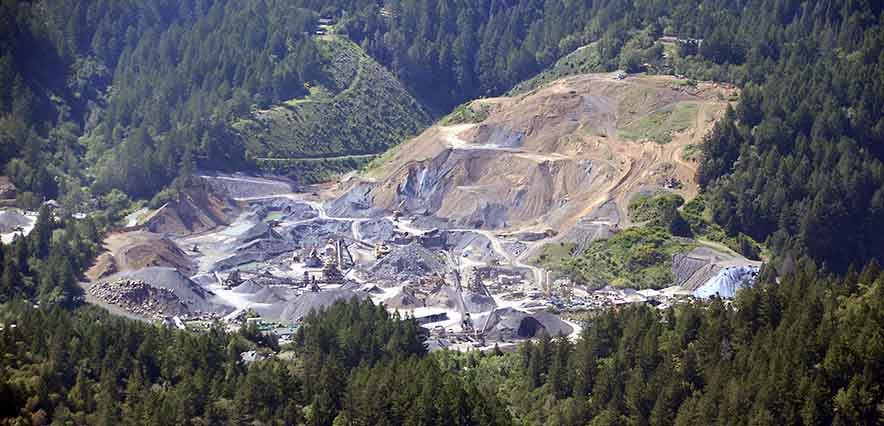Remote Detection
The word “quarry” has two derivations. One is from the Latin “quadrus,” or squared stone, which means an open excavation for obtaining stone. The second is from the Latin “corium,” or skin or hide, which came to mean prey or something to be captured. So it may seem fitting that thieves find rock quarries lucrative targets of plunder.
A successful theft ring was operating in central California, stealing valuable scrap copper wire and other materials in the middle of the night. One victim was Canyon Rock Quarry’s Forestville location. The facility had surveillance cameras around its property, but it had turned off the motion-detection capabilities due to frequent false alarms. James Trappe, a manager and one of the quarry’s owners, said that the video was merely serving a forensic purpose. “We have video of guys coming in, breaking in, and then leaving,” he says.
Quarry managers asked Bob Wolcott, founder of Wolcott Security, to assist them with finding a better camera solution. Wolcott tells Security Management that he knew the family- owned business would need cameras with plenty of built-in capabilities, because there is no IT network at the quarry. The system would also need to withstand the harsh environment. “It’s nothing but dust, dirt, and heat for the most part, and it’s really taxing on equipment,” Wolcott says of the quarry. “There isn’t a lot of infrastructure out there; it’s just a place where they’ve been extracting rock and gravel for years, so there hasn’t been any network of any kind out there.”
While researching potential solutions, Wolcott came across Mobotix cameras. After watching a demonstration video, he discovered that the cameras were used extensively in mining environments—another type of rugged operation. “That’s when they became a clearer choice for me,” Wolcott says. The quarry owners agreed with Wolcott’s assessment and, in June 2014, began installing the cameras.
The quarry now has nine cameras, a number that Wolcott says Canyon Rock plans to increase over time. Two of those are infrared cameras, allowing quarry owners to watch the facilities at night.
Built-in video analytics software detects motion but has a low rate of false alarms, such as those caused by moving tree branches or debris. Wolcott says this was an issue with Canyon Rock’s prior camera solution.
Another appeal for Wolcott was that no computers or servers are required to capture video. The cameras come with 4 gigabytes of storage, and network attached storage (NAS) boxes can be added to expand storage capacity even further.
Canyon Rock saves the video for 30 days, after which the cameras are set to overwrite. “Whenever there’s an important incident, we can archive that,” Wolcott notes, and he backs that video up on a thumb drive or optical disc.
The Mobotix mobile app is particularly useful for the quarry’s various operations, allowing the Canyon Rock owners to watch video live or review it from any device with an Internet connection.
Trappe says he uses the app for monitoring the video from his home, which is several miles from the quarry, but the connection can become slow when he tries to monitor too many cameras at once. To solve this, Wolcott set up radio links to the quarry owners’ houses, which are located on quarry property, so they can have full video viewing capabilities.
Trappe adds that the Mobotix connection uses less bandwidth than most connections. The software condenses the signal when streaming the images to a smartphone or tablet but then restores them on the device at full resolution.
During the night, the other quarry owners take turns monitoring the cameras, according to Trappe. In October, just a few months after the cameras were installed, Trappe’s brother Jonathon was on monitoring duty when the system alerted him to motion at the quarry. Upon reviewing the video, he saw that two men had broken in by crawling under an outer fence.
The quarry is located several miles away from the nearest law enforcement entity, so Jonathon called his brother and father, and they went to try to deter the intruders until police could arrive. The presence of the owners successfully thwarted the theft, but the thieves fled before police could reach the scene. The quarry gave the video to law enforcement.
Since the October incident, thieves have made attempts at another local quarry, but not at Canyon Rock.
“The system did exactly what it was supposed to do—detect them—and the owners were able to respond and get rid of the intruders,” Wolcott says.
One challenge of the Mobotix cameras is their price, Trappe says. However, he adds,“Watching someone walk out with stolen items is horrible–it’s a terrible feeling. So it was worth it for us to get that peace of mind.”
